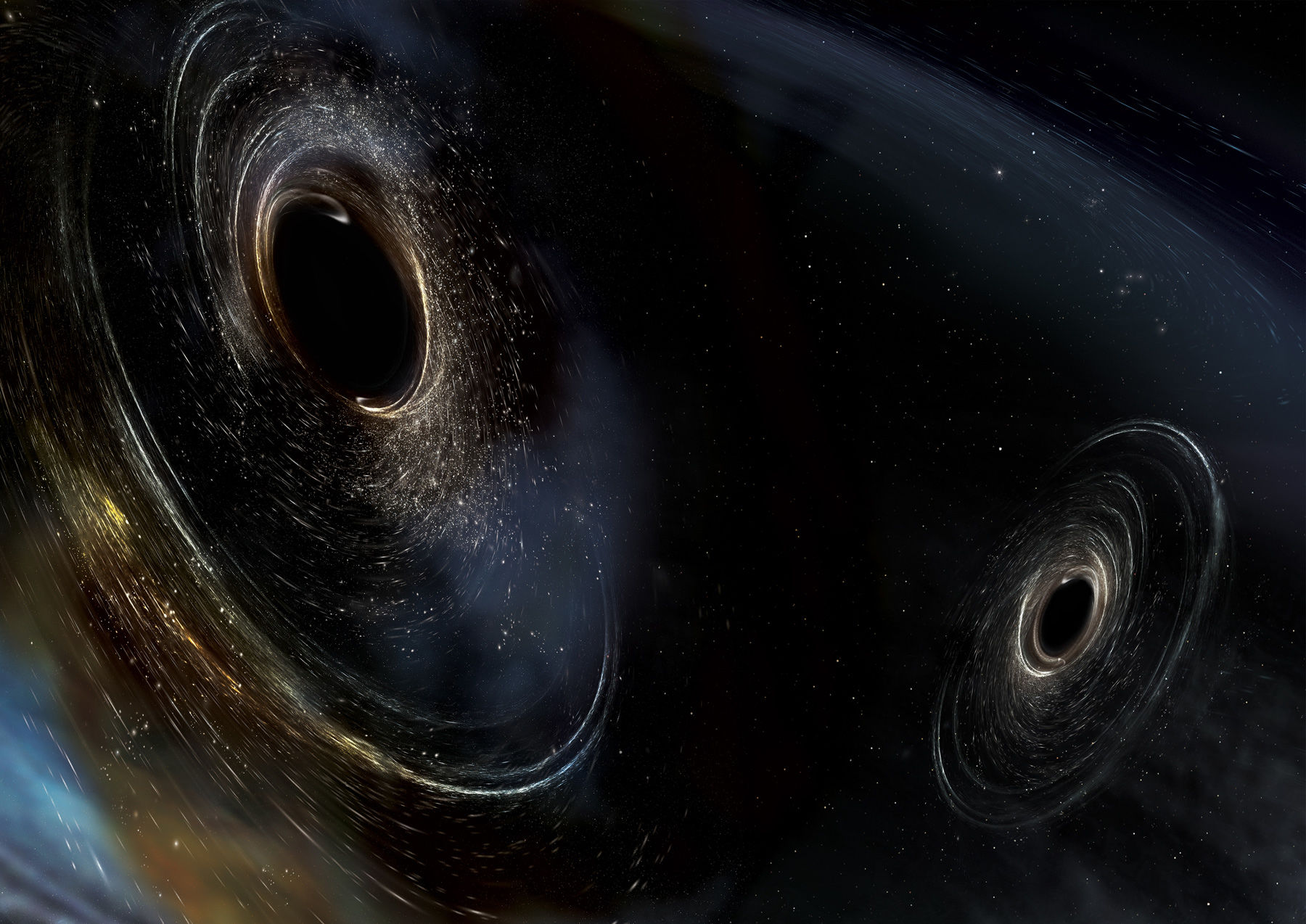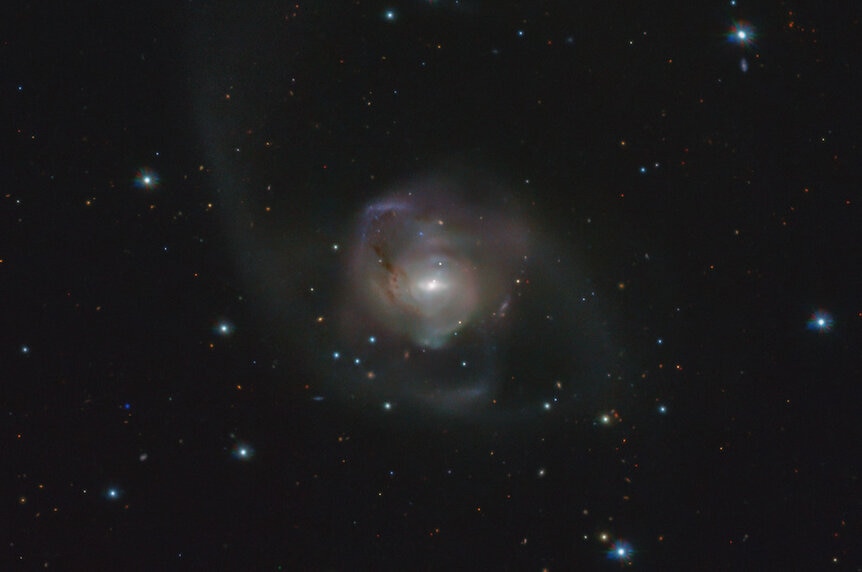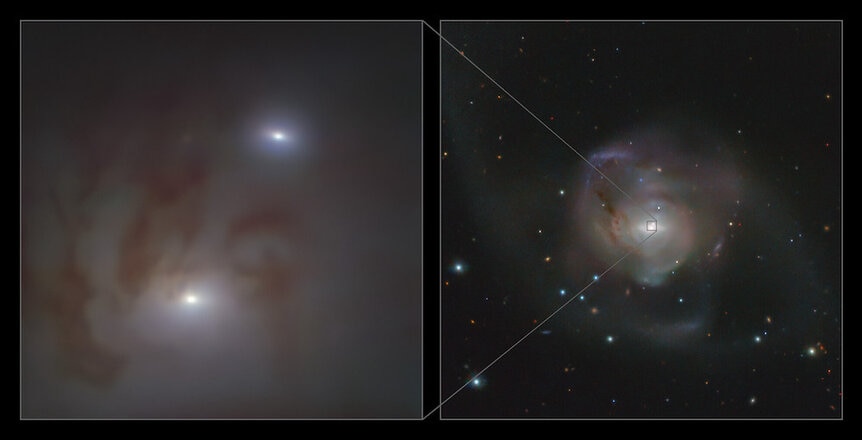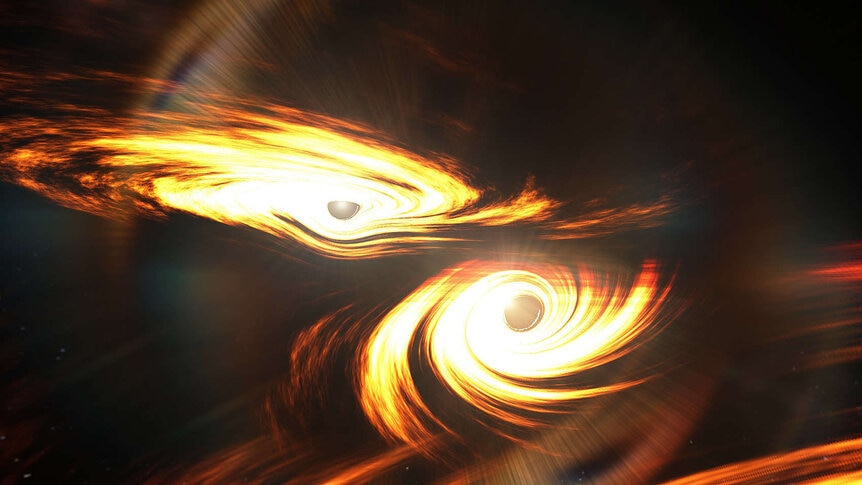Create a free profile to get unlimited access to exclusive videos, sweepstakes, and more!
Closest monster supermassive black hole pair to Earth found in a nearby galaxy
Duo will eventually spiral together and merge.

A team of astronomers has made a pretty exciting discovery: They have confirmed the existence of a relatively tight pair of supermassive black holes in a nearby galaxy, making them the closest such duo known!
Black holes up to about 100 times the mass of the Sun are called stellar-mass black holes, but far bigger ones exist. In the centers of all big galaxies lurk monsters: supermassive black holes, with millions and some with billions of times the mass of the Sun.
Many of these are found because they gobble down matter at a furious rate. This material piles up just outside the Point Of No Return in an enormous disk, which heats up to ridiculous temperatures and blasts out immense amounts of radiation. They're so bright they're relatively easy to find.
Some are quiet, though, and so we need other ways to detect them. There are lots of stars in the centers of galaxies, too. Ones closer to a supermassive black hole will be orbiting very rapidly, far faster than if a black hole weren't there. If this small volume of a galaxy can be seen clearly, it's possible to measure the stars' overall velocities, which can in turn be used to measure the black hole's mass.
Which brings us to NGC 7727. This is a spiral galaxy about 80 million light years away from Earth. However, unlike most majestic spirals, this one's arms are clearly messy, disturbed. Y'know, weird. This is very likely due to a recent merger with a smaller galaxy, a fairly common event.
Most spiral galaxies (including our Milky Way) have a central bulge of stars thousands of light years across which gets brighter toward the center. However, high-res images of the center of NGC 7727 show it has two bright spots in its heart, two nuclei.
One of them is brighter and right at the exact center of the galaxy. The other is fainter and offset a bit, at least 1,600 light years away (and maybe more since we see it in projection; it could be a little closer to us or farther away, making it a bit farther out from the brighter nucleus). This is exactly what you'd expect if NGC 7727 ate a smaller galaxy some time ago; the smaller one would fall toward the bigger's center over time.
Ah, but there's more. The center of fainter nucleus (let's call it Nucleus 2) is a source of X-rays, high-energy radiation you expect from a supermassive black hole eating matter. It also exhibits other indications of being a black hole.
To find out for sure, and to see if the brighter one (Nucleus 1) is also harboring a black hole, the astronomers turned to the Very Large Telescope in Chile and the Multi Unit Spectroscopic Explorer (MUSE), a camera capable of taking extremely high-resolution spectra of objects — breaking up their light into individual wavelengths (colors) which can then be used to measure the motions of objects via their Doppler shift.
They found clear evidence of supermassive black holes in both nuclei. The one in Nucleus 1 has a mass of 154 million (±10%) times the Sun's mass, so it's beefy (the central black hole in our Milky Way is "only" about 4 million solar masses).
Nucleus 2 has a black hole with a mass of 6.3 million solar masses (with a larger uncertainty of roughly 50%). This was harder to measure (hence the larger uncertainty) but is still a pretty solid detection.
Not only that, but they were able to get measurements of the total masses (including stars) of both nuclei. Nucleus 1 has a mass of about 50 billion Suns, and Nucleus 2 about 200 million. That confirms the fainter nucleus is lower mass, but more importantly it gives the ratios of black hole mass to star mass. For Nucleus 1 this ratio is 0.3% — about right for most galaxies — but for Nucleus 2 this ratio is 3%, which is far higher than usual.
But that makes sense too: As a small galaxy collides and merges with a bigger galaxy, its stars are stripped away by the bigger galaxy's gravity. The nucleus loses stars, so you expect the ratio of the black hole mass to that of the stars around it to go up. This clinches the idea that the double nucleus of NGC 7727 is from a merger, and the second galaxy had a smaller supermassive black hole.
This makes them the closest known supermassive black hole pair known. The previous record holder was NGC 6240, which is 300 million light years from Earth, over three times more distant than NGC 7727.
So what's next for this pair?
Gravitational interactions between the black hole in Nucleus 2 and the stars in the galaxy at large will continue to drop it toward the center. Once the two are close enough, they'll start to emit gravitational waves, lose energy, and approach closer and closer, spiraling together until WHAMMO. They merge, release a colossal blast of gravitational wave energy, and become as single, somewhat more supermassive black hole. Models of the encounter done by the team of astronomers show this is likely to happen in about 250 million years, and certainly no more than a billion.
Models of galaxy mergers indicate that there should be a lot more supermassive black hole pairs (or even binaries, where they orbit each other) than we currently see. It's likely most of them are quiet, so the only way to detect them is dynamically, through their affect on the stars around them. This is extremely hard to do — it was only possible here because the two were separated enough to resolve, and the galaxy is relatively close — but this confirmation makes it probable that more can be found.
One way black holes grow to be supermassive in the first place is through galactic mergers and eventual collisions of their central black holes. Most of our knowledge of this is theoretical, so it would be very cool to have more observations to hone that understanding. This may be the first time such a pair has been confirmed dynamically, but hopefully it's just the first.





























